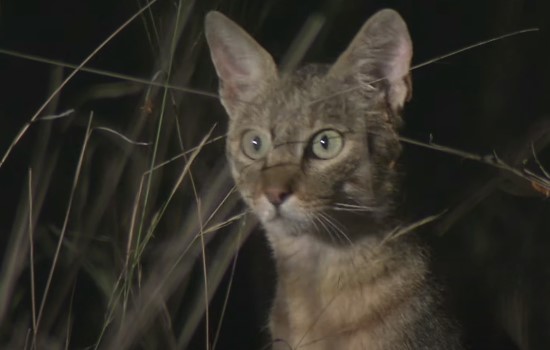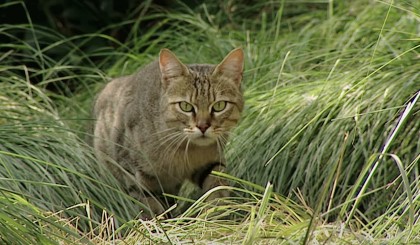Yes, you can keep wild cats as pets, but it’s important to understand their needs before making the commitment. Wild cats are not domesticated and have very different behaviors and natural instincts than our common house cats.
They require a lot of space to roam and explore, and they’re not typically content to stay indoors all day.
What is Wildcat?
The term “wild cat” can refer to a variety of small to medium-sized cats that are not domesticated.

Wild cats are typically solitary animals that hunt and live in forests or other wild areas. They are carnivores and prey on small mammals, birds, and reptiles.
Wild cats are an important part of the ecosystem and play a role in controlling populations of other animals.
It is important to note that it is illegal to own a wild cat as a pet in many countries. Even in countries where it is legal, there are often strict regulations on the ownership of wild cats.
If you are considering owning a wild cat, it is important to do your research and make sure that you are following the law.
Some of the most common wild cat species include European wildcat, African wildcat, Savannah cat, Ocelot, and Lynx.
Things to Considering a Wild Cat as a Pet
If you’re considering a wild cat as a pet, be prepared to provide an enclosure that is large enough for them to move around freely in and that has stimulating enrichment activities like climbing structures and hiding places.
- Obtain a wild cat from a legal source.
- Have the cat checked by a veterinarian to ensure it is healthy and does not have any communicable diseases.
- Spay or neuter the cat to prevent unwanted litters of kittens.
- Vaccinate the cat against common feline diseases such as rabies, panleukopenia, and feline leukemia virus.
- Keep the cat indoors at all times to protect it from predators, disease, and traffic hazards.
- Provide the cat with plenty of stimulating toys and activities to keep it occupied and mentally stimulated.
- Feed the cat a high-quality diet formulated for cats to ensure that it gets all of the nutrients it needs.
What Wild Cats Do People Keep As Pets?
There are a variety of wild cats that people keep as pets. The most popular include the Bengal, Savannah, and Chausie. Each of these breeds has unique physical and personality traits that make them appealing to cat lovers.
Bengals
Bengals are renowned for their beautiful leopard-like markings and playful dispositions. They are also very active cats, requiring plenty of space to run and play.
Bengals can be quite vocal, so if you’re looking for a quiet pet kitty this may not be the breed for you.
Savannahs
Savannahs are another popular choice for those seeking an exotic pet cat. These regal felines are tall and slender, with long legs and big ears. They are also very intelligent and can be trained to perform tricks or even walk on a leash!
Savannahs require less maintenance than some other breeds, making them ideal for busy families or individuals.
Chausie
Chausies are a relatively new breed that is created by crossing a domestic cat with a jungle cat species (usually a Geoffroy’s cat).
As such, they inherit the best traits of both worlds – the striking appearance of their wild ancestors coupled with the friendly disposition of domesticated cats.
Chausies typically have high energy levels and love to explore, so they need plenty of room to roam.
European wildcat
The European wildcat is a native feline of Europe’s forests. Resembling domestic cats, it has a bushy tail and striped coat. Its secretive nature and habitat loss contribute to its status as a threatened species in parts of its range.
African wildcat
The African wildcat is the ancestor of domestic cats. Found across Africa and the Middle East, it has a sandy gray coat, a shorter tail and striped legs. It’s adapted to various habitats, from savannas to deserts, and retains its wild instincts.
Ocelot
The ocelot is a striking wild cat native to the Americas. Recognizable by its tawny fur and black spots, it’s skilled in climbing and hunting. The spotted coat also can be yellow, orange, or brown.
Habitat loss and illegal trade are major threats to its populations.
Lynx
This cat is native to North America, Europe, and Asia, and is about the size of a large domestic cat. It has a tawny coat with black ear tufts and a short tail. Lynx are skilled hunters.
They inhabit diverse habitats but face challenges due to habitat fragmentation and human conflict.
Are Wild Cats Safe to Be Kept as a Pet?
Wild cats can be kept indoors, but it is important to take precautions to ensure their safety and the safety of your family.

If you adopt a wild cat from a shelter or rescue organization, make sure to ask about its history and temperament. Some wild cats may be more aggressive than others and may not be suitable for indoor living.
Wild cats need a lot of room to exercise and explore. If you have a small home, you may want to consider building a catio or outdoor enclosure for your cat. Wild cats are naturally curious and active animals.
They need toys and activities to keep them entertained and prevent them from becoming bored or destructive.
Why Wild Cats is not as good as Pets?
Keeping wild cats as pets is not a good idea due to a multitude of reasons ranging from safety concerns to ethical considerations.
While the allure of having an exotic and majestic creature in your home might be enticing, the realities of owning a wild cat quickly outweigh the perceived benefits.
1. Safety Concerns: Wild cats, including species like lions, tigers, leopards, and cheetahs, are apex predators with powerful instincts and behaviors that are not suitable for a domestic environment.
These animals have evolved to survive in the wild and possess hunting instincts that can translate into dangerous behaviors indoors. Even if raised from a young age, their unpredictable nature can lead to sudden outbursts of aggression or territorial behaviors.
The physical strength of wild cats poses a significant risk to human safety, and they can cause serious injuries to owners, family members, or visitors.
2. Space and Enrichment Needs: Wild cats require extensive space to roam, explore, and exercise. The confinement of indoor living deprives them of their natural instincts to roam vast territories.
The lack of physical and mental stimulation can lead to boredom, frustration, and stress, which in turn can result in behavioral problems, depression, and health issues.
3. Dietary Requirements: Wild cats have specific dietary needs that are challenging to meet in a home setting. Their diets often consist of raw meat, bones, and specialized nutrients that are not readily available or safe to provide at home.
Inadequate nutrition can lead to health problems and deficiencies that affect their overall well-being.
4. Health and Disease Risk: Wild cats may carry diseases that can be transmitted to humans and other pets. Regular veterinary care for these animals can be complex and costly.
Diseases that may not affect wild cats in the wild can become problematic in captivity due to the altered environment and stressors they experience.
5. Ethical Considerations: Owning a wild cat as a pet contributes to the demand for captive-bred exotic animals. This can lead to unethical practices, including wildlife trafficking and breeding for profit.
Many wild cat species are endangered, and removing them from their natural habitats can negatively impact conservation efforts.
6. Legal Restrictions: Many countries and states have strict regulations or outright bans on owning wild cats as pets. These laws exist to protect the animals and public safety. Attempting to keep a wild cat without the necessary permits can result in legal consequences.
7. Longevity and Commitment: Wild cats can have lifespans similar to those of domestic cats, and their long lifespan means a long-term commitment. As these animals age, their needs become more complex, and finding appropriate care can become even more challenging.
8. Lack of Domestication: Wild cats are not domesticated like common domestic cat breeds. Domestication is a process that occurs over many generations, involving selective breeding for traits that are suitable for living with humans.
Wild cats have not undergone this process, so their natural behaviors and instincts remain intact.
Wild And Domestic Cat Cross Breeding

Wild and domestic cat crossbreeding refers to the intentional mating of a wild cat species with a domestic cat breed.
This practice is often done with the aim of producing offspring that exhibit a combination of the physical traits of the wild cat and the temperament of the domestic cat.
What is Wild and Domestic Cat Cross Breeding
Wild and domestic cat crossbreeding involves mating a wild cat species, such as a serval, caracal, or leopard, with a domestic cat breed, like the Bengal or Savannah cat.
The goal is to create cats that have the striking appearance of their wild counterparts while maintaining a more manageable and domesticated temperament.
How it is Done
Wild and domestic cat crossbreeding requires controlled mating between a male wild cat and a female domestic cat. The resulting kittens may inherit physical traits like distinctive coat patterns, large ears, and athletic builds from their wild parent.
Crossbreeding is often followed by multiple generations of selective breeding to gradually reduce the wild traits and ensure a more predictable temperament.
Potential Benefits of Cross Breeding
Crossbred cats can have stunning and unique appearances, which may appeal to individuals interested in owning a cat that resembles a wild species. Some crossbred cats may inherit the athleticism and agility of their wild parent, making them active and engaging companions.
Crossbreeding can contribute to public education about wild cat conservation, raising awareness about endangered species and their natural behaviors.
Considerations and Concerns
Crossbreeding can raise ethical concerns about altering the genetics of wild animals for human preferences. It blurs the line between wild and domestic animals and may perpetuate the misconception that wild animals can be fully domesticated.
Even after several generations of breeding, wild instincts may persist, leading to unpredictable behaviors that can be challenging to manage in a domestic setting.
Laws and regulations surrounding crossbreeding vary by location. In some places, owning or breeding certain crossbred cats might be illegal due to concerns about wildlife conservation.
Crossbreeding can introduce health problems associated with both wild and domestic species, potentially affecting the well-being of the cats.
Owning a crossbred cat can come with unique challenges related to care, socialization, and understanding their complex needs.
References:
- https://wildcatconservation.org/wild-cats-as-pets/
- https://www.ncbi.nlm.nih.gov/pmc/articles/PMC5790555/
- https://www.science.org/content/article/genes-turned-wildcats-kitty-cats
- https://www.doi.gov/blog/wild-cats-adventure-felines
His professional interests include humane education, ethics, small animal behavior, and veterinary. As a pet lover from school life, having grown up with two cats and a dog. If he isn’t spending time with his friends and family, Justin enjoys traveling. Learn more about Justin here.
